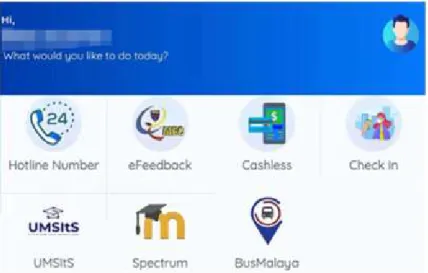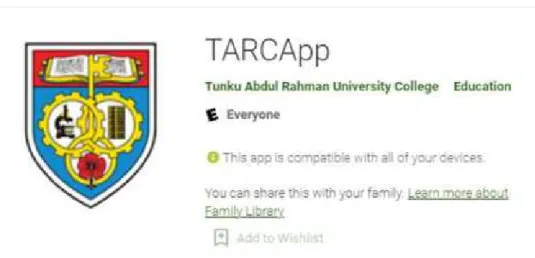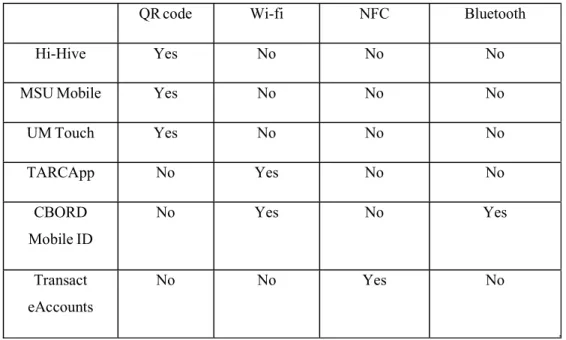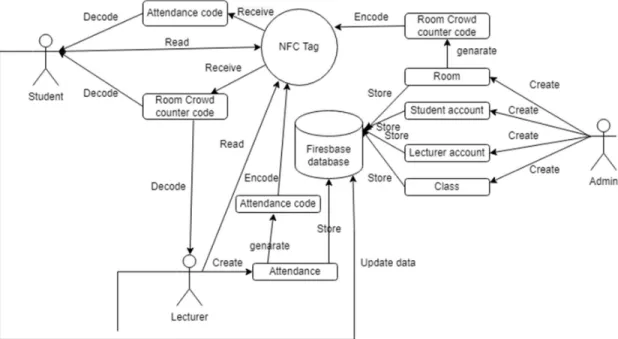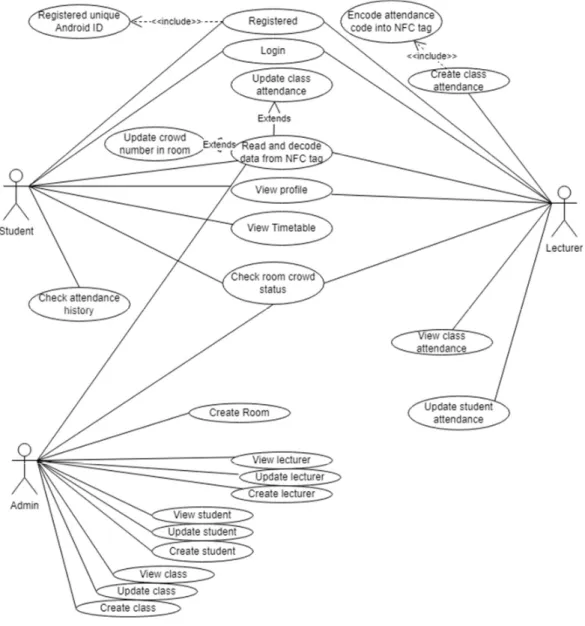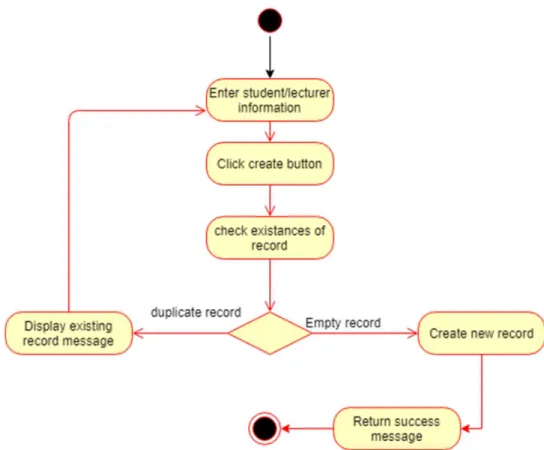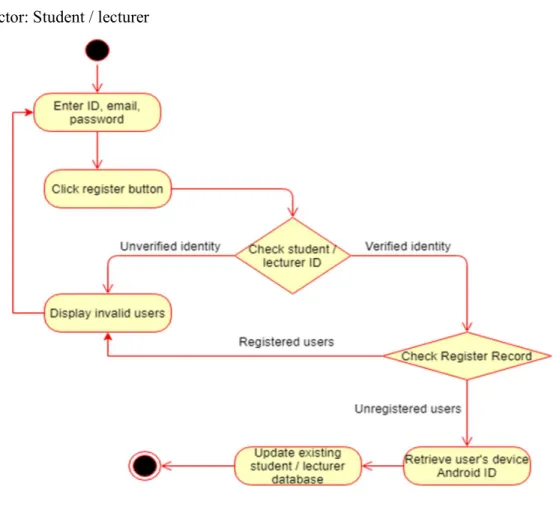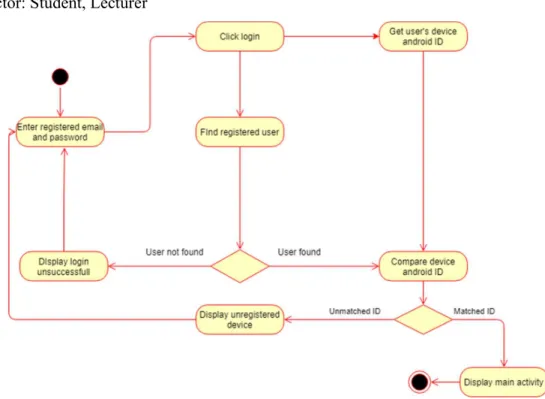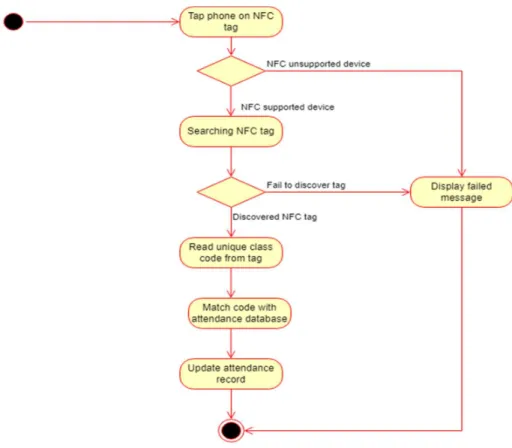DIGITAL STUDENT ID CARD USING NFC TECHNOLOGY By
Eng Mun Shuen
A REPORT SUBMITTED TO Universiti Tunku Abdul Rahman in partial fulfillment of the requirements
for the degree of
BACHELOR OF INFORMATION SYSTEMS (HONOURS) INFORMATION SYSTEMS ENGINEERING
Faculty of Information and Communication Technology (Kampar Campus)
JAN 2022
DIGITAL STUDENT ID CARD USING NFC TECHNOLOGY By
Eng Mun Shuen
A REPORT SUBMITTED TO Universiti Tunku Abdul Rahman in partial fulfillment of the requirements
for the degree of
BACHELOR OF INFORMATION SYSTEMS (HONOURS) INFORMATION SYSTEMS ENGINEERING
Faculty of Information and Communication Technology (Kampar Campus)
JAN 2022
iii Bachelor of Information Systems (Honours) Information Systems Engineering
Faculty of Information and Communication Technology (Kampar Campus), UTAR
REPORT STATUS DECLARATION FORM
Title: __Digital Student ID Card Using NFC Technology________________
__________________________________________________________
__________________________________________________________
Academic Session: January 2022
I __________________Eng Mun Shuen___________________________
(CAPITAL LETTER)
declare that I allow this Final Year Project Report to be kept in
Universiti Tunku Abdul Rahman Library subject to the regulations as follows:
1. The dissertation is a property of the Library.
2. The Library is allowed to make copies of this dissertation for academic purposes.
Verified by,
_________________________ _________________________
(Author’s signature) (Supervisor’s signature)
Address:
1,Jalan Sri Klebang 5
Bandar Baru Sri Klebang Wong Pei Voon
Chemor Perak,31200 Supervisor’s name
Date: 22/04/2022 Date: 22/04/2022
iv Bachelor of Information Systems (Honours) Information Systems Engineering
Faculty of Information and Communication Technology (Kampar Campus), UTAR
FACULTY OF INFORMATION AND COMMUNICATION TECHNOLOGY
UNIVERSITI TUNKU ABDUL RAHMAN
Date: 19 / 04/ 2022
SUBMISSION OF FINAL YEAR PROJECT
It is hereby certified that ______Eng Mun Shuen (ID No: __18ACB03271 ) has completed this final year project entitled “_DIGITAL STUDENT ID CARD USING NFC TECHNOLOGY___ _”
under the supervision of ___Ts Dr Wong Pei Voon________ (Supervisor) from the Department of ____Digital Economy Technology___________, Faculty of _______Information and Communication Technology_____________
I understand that University will upload softcopy of my final year project in pdf format into UTAR Institutional Repository, which may be made accessible to UTAR community and public.
Yours truly,
___________________
(ENG MUN SHUEN)
*Delete whichever not applicable
v Bachelor of Information Systems (Honours) Information Systems Engineering
Faculty of Information and Communication Technology (Kampar Campus), UTAR
DECLARATION OF ORIGINALITY
I declare that this report entitled “DIGITAL STUDENT ID CARD USING NFC TECHNOLOGY” is my own work except as cited in the references. The report has not been accepted for any degree and is not being submitted concurrently in candidature for any degree or other award.
Signature : _________________________
Name : _Eng Mun Shuen___________
Date : __19-04-2022______________
vi Bachelor of Information Systems (Honours) Information Systems Engineering
Faculty of Information and Communication Technology (Kampar Campus), UTAR
I would like to express my sincere thanks and appreciation to my supervisor, Ts Dr Wong Pei Voon who has given me this bright opportunity to develop a mobile application project. It is my first step to establish a career in mobile application development field. A million thanks to you.
Finally, I must say thanks to my parents and my family for their love, support, and continuous encouragement throughout the course.
vii Bachelor of Information Systems (Honours) Information Systems Engineering
Faculty of Information and Communication Technology (Kampar Campus), UTAR
Most of the education institution, student and lecturer are given an identity card that could identify themselves. It is important to protect the personal information data on the card from identity thief in this era of big data. Besides, traditional Identity Card management is inefficient. Education institution which still using traditional ID card will waste a lot of resources on managing the cards. Not to mention that the ID card could not be reused, cause a lot of harm to the environment. Student ID card are designed to perform multiple functions. One of the functions is to take class attendance.
Some institution uses different types of attendance taking method and these methods have their disadvantages.
This mobile android application project is designed to replace the traditional ID card.
This application will give users a more secured authorized identity in the education institution area by registering each device’s unique Android ID. Besides, this application provides attendance management function for admin and attendance taking function for student and lecturer. NFC technology will be implemented to become the attendance taking method. NFC technology is not only safe, but also could utilize the attendance taking process. Most importantly, it could increase the attendance rate and improve the attendance data accuracy. This application will be developed using Android Studio IDE and Firebase cloud database.
viii Bachelor of Information Systems (Honours) Information Systems Engineering
Faculty of Information and Communication Technology (Kampar Campus), UTAR
REPORT STATUS DECLARATION FORM iii
FYP THESIS SUBMISSION FORM iv
DECLARATION OF ORIGINALITY v
ACKNOWLEDGEMENTS vi
ABSTRACT vii
TABLE OF CONTENTS viii
LIST OF FIGURES x
LIST OF TABLES xiii
LIST OF ABBREVIATIONS xv
CHAPTER 1 INTRODUCTION 1
1.1 Problem Statement 1
1.2 Motivation 3
1.3 Project Objectives 5
1.4 Project Scope 6
1.5 Impact, significance, and contribution 7
1.6 Report Organization 8
CHAPTER 2 LITERATURE REVIEW 10
2.1 Review of Technologies 10
2.1.1 Hardware Platform 10
2.1.2 Firmware/OS 12
2.1.3 Database 12
2.1.4 Programming Language 13
2.2 Review of the Existing Systems/Applications 14
2.2.1 Hi-Hive, MSU Mobile, UM Touch 14
2.2.2 TARCApp 20
2.2.3 CBORD Mobile ID 22
2.2.4 Transact eAccount 24
2.2.5 My-UU application 26
2.2.6 UiTM iStudent 28
ix Bachelor of Information Systems (Honours) Information Systems Engineering
Faculty of Information and Communication Technology (Kampar Campus), UTAR
CHAPTER 3 SYSTEM METHODOLOGY/APPROACH 31
3.1 System Design Diagram 31
3.2 Use Case 32
3.3 Use case description 34
3.4 Activity Diagram 54
CHAPTER 4 SYSTEM DESIGN 64
4.1 System Block Diagram 64
4.2 System Components 65
4.3 System Flowchart 77
CHAPTER 5 SYSTEM IMPLEMENTATION 80
5.1 System Operation 80
CHAPTER 6 SYSTEM EVALUATION AND DISCUSSION 98
6.1 Testing Setup and Result 98
6.2 Project Challenges 108
6.3 Objectives Evaluation 109
CHAPTER 7 CONCLUSION AND RECOMMENDATION 110
7.1 Conclusion 110
7.2 Recommendation 111
REFERENCES 112
APPENDIX A-1
WEEKLY LOG A-1
POSTER A-7
PLAGIARISM CHECK RESULT A-8
FYP2 CHECKLIST A-12
x Bachelor of Information Systems (Honours) Information Systems Engineering
Faculty of Information and Communication Technology (Kampar Campus), UTAR
Figure Number Title Page
Figure 2.1.1 NFC magnetic field from initiator and Tag
11
Figure 2.2.1 Logo of Hi-Hive application 14
Figure 2.2.2 Logo of UM Touch application 15
Figure 2.2.3 Logo of MSU Mobile application 15
Figure 2.2.4 Location QR code and Attendance QR code
16
Figure 2.2.5 Inactivate attendance QR code 16
Figure 2.2.6 Hi-Hive Attendance record 16
Figure 2.2.7 UM touch interface 17
Figure 2.2.8 UM touch QR code attendance 17
Figure 2.2.9 Logo of TARCApp application 20
Figure 2.2.10 Logo of CBORD Mobile ID application 22 Figure 2.2.11 Logo of Transact eAccounts application 24
Figure 2.2.12 Logo of MyUU application 26
Figure 2.2.13 Logo of UiTM iStudent 28
Figure 3.1.1 System Architecture Diagram 31
Figure 3.2.1 Use case diagram 32
Figure 3.4.1 Create student/lecturer activity diagram 54
Figure 3.4.2 register activity diagram 55
Figure 3.4.3 login activity diagram 56
Figure 3.4.4 Attendance taking and decode data from NFC tag activity diagram
57
Figure 3.4.5 Create attendance and encode attendance code into NFC tag activity diagram
58
Figure 3.4.6 Update existing student/lecturer activity diagram
59
xi Bachelor of Information Systems (Honours) Information Systems Engineering
Faculty of Information and Communication Technology (Kampar Campus), UTAR
Figure 3.4.8 Create room activity diagram 61
Figure 3.4.9 Update class 62
Figure 3.4.10 Update crowd number in room and decode data from NFC tag
63
Figure 4.1 System Block Diagram 64
Figure 4.2.1 Attendance class 66
Figure 4.2.2 Student class 66
Figure 4.2.3 Lecturer class 67
Figure 4.2.4 Peoplecounter class (Room Crowd Counter)
67
Figure 4.2.5 Classes class 68
Figure 4.3.1 Admin flow chart 77
Figure 4.3.2 Lecturer flowchart 78
Figure 4.3.3 Student flowchart 79
Figure 5.1.1 Student information input field 80
Figure 5.1.2 Complete student information input field 80
Figure 5.1.3 Lecturer information input field 81
Figure 5.1.4 Complete lecturer information input field 81
Figure 5.1.5 Student list 82
Figure 5.1.6 Update student information input field 82
Figure 5.1.7 Lecturer list 83
Figure 5.1.8 Update lecturer information input field 83
Figure 5.1.9 Student ID input 84
Figure 5.1.10 Student profile 84
Figure 5.1.11 Lecturer ID input 85
Figure 5.1.12 Lecturer Profile 85
Figure 5.1.13 New class input field 86
Figure 5.1.14 New class student list field 86
Figure 5.1.15 Class list 87
xii Bachelor of Information Systems (Honours) Information Systems Engineering
Faculty of Information and Communication Technology (Kampar Campus), UTAR
Figure 5.1.18 Class destribtion 88
Figure 5.1.19 Class Student List 88
Figure 5.1.20 Student Profile 88
Figure 5.1.21 Room Details input field 89
Figure 5.1.22 Success Room Details input 89
Figure 5.1.23 Room list 91
Figure 5.1.24 Room status 91
Figure 5.1.25 Lecturer Profile 92
Figure 5.1.26 Student Profile 92
Figure 5.1.27 Class attendance creation default input field
93
Figure 5.1.28 Attendance date selection 93
Figure 5.1.29 Attendance class hour selection 94
Figure 5.1.30 Success attendance class creation 94 Figure 5.1.31 Lecturer view class attendance main page 95 Figure 5.1.32 Lecturer view attendance date selection 95 Figure 5.1.33 Student class attendance status list 95
Figure 5.1.34 Attendance update menu 95
Figure 5.1.35 Student class attendance list 96
Figure 5.1.36 Student class attendance status 96
Figure 5.1.37 Attendance taking main page 97
Figure 5.1.38 Success attendance success page 97
xiii Bachelor of Information Systems (Honours) Information Systems Engineering
Faculty of Information and Communication Technology (Kampar Campus), UTAR
Table Number Title Page
Table 2.3 Mobile application attendance method 30
Table 3.3.1 Register account use case 34
Table 3.3.2 Login use case 35
Table 3.3.3 Create student/ lecturer use case 36
Table 3.3.4 Create class use case 37
Table 3.3.5 View class use case 38
Table 3.3.6 Update class use case 39
Table 3.3.7 View student / lecturer use case 40
Table 3.3.8 Update student / lecturer use case 41
Table 3.3.9 Create Room use case 42
Table 3.3.10 Read and decode data from NFC tag use case 43
Table 3.3.11 Update class attendance use case 44
Table 3.3.12 Update Crowd number in room use case 45
Table 3.3.13 View Profile use case 46
Table 3.3.14 View timetable use case 47
Table 3.3.15 Check attendance history use case 48
Table 3.3.16 Check room crowd status use case 49
Table 3.3.17 Create class attendance use case 50
Table 3.3.18 Encode attendance code in NFC tag use case 51
Table 3.3.19 View class attendance use case 52
Table 3.3.20 Update student attendance use case 53
xiv Bachelor of Information Systems (Honours) Information Systems Engineering
Faculty of Information and Communication Technology (Kampar Campus), UTAR
Table 6.1.2 Login 99
Table 6.1.3 Create student/ lecturer 100
Table 6.1.4 Create class 100
Table 6.1.5 View class 101
Table 6.1.6 Update class 101
Table 6.1.7 View student / lecturer 102
Table 6.1.8 Update student / lecturer 102
Table 6.1.9 Create Room 103
Table 6.1.10 Read and decode data from NFC tag 104
Table 6.1.11 Update class attendance 104
Table 6.1.12 Update Crowd number in room 105
Table 6.1.13 Check attendance history 105
Table 6.1.14 Check room crowd status 106
Table 6.1.15 Create class attendance 106
Table 6.1.16 Encode attendance code in NFC tag 107
Table 6.1.17 View class attendance 107
Table 6.1.18 Update student attendance 108
xv Bachelor of Information Systems (Honours) Information Systems Engineering
Faculty of Information and Communication Technology (Kampar Campus), UTAR API Application Programming Interface
CRUD Create, Read, Update, Delete
GPS Global Positioning System
ID Identity
NFC Near Field Communication
PVC Polyvinyl chloride
QR Quick Response
RAD Rapid Application Development
RFID Radio-Frequency Identification
SDK Software Development Kit
SIM Subscriber Identity Module
SQL Structured Query Language
SDLC System Development Life Cycle Wi-Fi Wireless Fidelity
1 Bachelor of Information Systems (Honours) Information Systems Engineering
Faculty of Information and Communication Technology (Kampar Campus), UTAR CHAPTER 1
Introduction
This proposal is aiming to replace the traditional student card with digital mobile student card. There are a few problems with the traditional physical student card.
1.1 Problem Statement
i) Physical card can be easily mislaid
Student must bring along their identity student card with them when they are inside the campus area. Student ID card is used to prove student identity and they will be punished for forgetting their student card. However, there are many cases where student forget to bring student card with them. According to Sumathi Reddy, people misplace their belongings in an average less than 10 times daily and spending more than 10 minutes to search for the missing item [1]. These items could be keys, identity cards, mobile devices or another item that is small.
Generally, student ID card are only usable in school area and student could use the card to purchase food, borrow books from library or access building. Yet not all student’s identity card from different school has all these features. Student tends to forget their student card when their student card is not important, and they have no issue to access school area and attending class. Besides, whenever student come back from school, they will take off their student ID card because these cards are unusable outside the school area. Then, students will face the situation to search for their misplaced ID cards tomorrow.
ii) Traditional card is unsecured
There is printed student’s information on every student card. The general main elements of student identity card are printed picture, printed personal information, printed education institution information, student identifying number and so on. Besides, some advanced identity card has magnetic stripe, bard code, integrated circuit chip or RFID tag that could store student’s personal information. However, this information are not carefully protected. First, information inside the magnetic strip is encoded according to international standards. People could decode and obtain the information by using magnetic strip equipment that can be easily purchased. Student personal photo could also lead to security issue. In some cases, leaking of student information could lead to
2 Bachelor of Information Systems (Honours) Information Systems Engineering
Faculty of Information and Communication Technology (Kampar Campus), UTAR
criminal cases. Identity thief could use the student information on the card such as picture to create some fake video or photo with your face. One of the threats of faking the video or photo could lead to serious image-abused and cyberbullying cases among the society [2]. Other than that, fake student card also has the security risk. People who printed a fake student card on PVC or plastic card could access the building anytime.
Any educational institution does not welcome unauthorize visitors.
iii) Inefficient physical card management system
Traditional card is not easy to manage, and it will consume a lot of resources and time.
To create a new student ID card, administration must purchase PVC cards and print student information on each of it. Whenever student want to update their student information, their student ID card might also need to be replaced with a new card.
Administration must replace the old identity card and remake an updated card for the student. Besides, replacing ID card must go through the identity verification process and it will usually take times for the admin to go through the process. Usually, it might take hours or days to process the card replacement process.
3 Bachelor of Information Systems (Honours) Information Systems Engineering
Faculty of Information and Communication Technology (Kampar Campus), UTAR 1.2 Motivation
Mobile identity card also be defined as a form of digital identity that could represent a person’s credentials through the digital devices, mobile network. [3]. According to an interview article written by Salim in 2016, the International Student Identity Card Organization hope to replace traditional physical student ID card with mobile student card. The reason behind this statement is the organization believe that mobile student card would bring a lot of benefits to students and might improve student learning experience in school [4]. There are motivations in solving the problem of traditional student card.
The first problem of using physical student card is student might forget to bring along their student card with them and they could be punished with that. Replacing physical card with mobile application can solve this problem. Nowadays people will bring their mobile phone with them all the time. People use mobile phone to perform different type of daily operation such as communication, learning, entertaining and so on. Compare to student card that are usually only usable within school area, student would not easily forget their mobile phone that could be use inside or outside school area. Therefore, replacing traditional student ID card with mobile phone could ensure student are capable to have a evidence of authority in their phone.
Protect student personal information will be the second motivation of this project. It is important to keep the student information confidential and secured. Identity thief could use this information to commit crime and danger the student. Mobile smart phone is one of the solution to solve this problem because smart phone could provide a lot of security protection features compare to physical card. There could be a lot of security layer inside a smart phone. For example, student could set a password, pattern, or pin on the smart phone. Besides that, the data inside the mobile application can be encrypted uniquely and it is not that easy to decode the encrypted data compare to magnetic strip which the data is encoded according to international standards. Moreover, there are also a lot of security features such as two-factor authentication, multi-factor authentication, biometric authentication, behavioural authentication and so on.
Utilizing the student identity card management will be the third motivation. It is important to have more efficient and effective system and reduce the time and effort to
4 Bachelor of Information Systems (Honours) Information Systems Engineering
Faculty of Information and Communication Technology (Kampar Campus), UTAR
manage the physical student ID card. This problem could be solved by replacing physical student card with mobile application. Student do not have to worry their student ID card will be lost since all the student information is stored permanently inside the cloud database. The cost and time to replace and update the student identity will be shorten.
Other than that, there are a lot of features from traditional physical card that could be also operate using mobile application such as student could use student card to take attendance. This mobile application also could perform the attendance taking features too. Using mobile application to manage attendance is more efficient. Some education institutions are still taking student attendance by signing on a list of students or using physical student card to take attendance. One of the main problems with these attendance taking methods is student faking attendance. People will sign for their friends who are absent. Besides, it is also difficult to manage the attendance record when lecturer or teacher record the attendance manually on paper. Then they must update the attendance record one by one into the database manually. To utilize the attendance management system for both student and teacher, mobile application will have a much better performance in handling the system.
5 Bachelor of Information Systems (Honours) Information Systems Engineering
Faculty of Information and Communication Technology (Kampar Campus), UTAR 1.3 Project Objectives
i) Enhance of the security to protect student information in mobile application All student and lecturer information is protected inside the cloud database.
Unauthorized user could not perform log in operation using another student and lecturer account into their device. Each user’s Android - ID is unique, and it will be bind with each user’s account once they registered an account for this application.
ii) Utilize the student attendance system by using NFC technology
Using NFC to take attendance could speed up the attendance record process. Student just tap their mobile device on the NFC tag and the attendance will be updated inside the device database. Other than that, the lecturer could collect and record the attendance automatically after students tap their phone on the NFC tag. It utilizes lecturer time instead of dealing with the student attendance data. One of the advantage of using NFC technology is simplicity and convinience. Comparing to other data storing method such as QR code and bar code, the cost is cheaper.
iii) To improve the attendance rate of student
Every student must appear physically in front of the NFC tag to record attendance and each student account is binding with only one registered mobile device. Therefore, there will be a reduce number of fake attendance and the attendance rate will be increase. Student could not sign the attendance for their friends and the accuracy of the attendance data will be improved.
6 Bachelor of Information Systems (Honours) Information Systems Engineering
Faculty of Information and Communication Technology (Kampar Campus), UTAR 1.4 Project Scope
i) Verified user identity using mobile application
Student and lecturer identity could be verified through this application. When user register with their identical student or lecturer ID into this mobile application, the Android Identity code from user’s device will be retrieved and store on the database.
Each registered student will be bind with one and only mobile device. Meaning that each student and lecturer could not log in into different mobile device after they registered themselves.
ii) Attendance taking method using NFC
Before student take the attendance using NFC chip on their phone, lecturer could write the unique class code inside an NFC tag. Whenever student attend to a class, student tap their phone on the NFC tag that prepared by lecturer and the attendance will be updated and recorded. Besides, teacher could retrieve and collect all student’s attendance record from the cloud database using their mobile phone.
iii) Student Attendance management system
Student, lecturer, and the administrator could always view and check the attendance record on the application. All the attendance record is updated and stored inside the cloud database. They could view the attendance with their mobile phone. Administrator for this application could perform create, update and read operation on the attendance system and student information database. All these operations could be performed on mobile device and the modification will be updated on the cloud server.
iv) Can write message on the NFC tag
Every user could perform write and read message on the NFC tag. User could leave any short message into the NFC tag for notice purpose. Other than that, the code that encoded into the NFC tag can be also used to perform attendance taking function and people counter function.
7 Bachelor of Information Systems (Honours) Information Systems Engineering
Faculty of Information and Communication Technology (Kampar Campus), UTAR 1.5 Impact, significance and contribution
i) Attendance rate will be improved
Using NFC technology as attendance taking method will improve the attendance rate.
This is because student could not fake their attendance. Student must present to the in front of the NFC tag and tap their phone on the NFC tag to take attendance. Besides, each student could only bind one smart phone to the mobile application. Students are not allowed to register same mobile device and log in into the multiple account in more than 1 devices. Therefore, student must physically attend to the class to take attendance.
When the attendance rate is improved and accurate, it could help an education institution to have a deeper understand on the student condition based on the attendance rate. Using the attendance data could also help the education institution to design and some plans and strategy to improve student. According to GreatSchools Staff in 2011, higher attendance rate also mean students will have higher changes to succeed in their academic [5]. Having more excellent student also will boost the ranking of the education institution and become more successful.
ii) Stronger security protection for student
Replacing traditional student card with the mobile application could secure student.
Besides, using NFC technology to take attendance is more secure compare to QR code.
It is proven by Deliyannis, NFC perform better in security because the user must get close to the NFC tag or NFC device to perform data transaction operation [6]. On the other hand, QR code is not secure compare to NFC because user could access to the URL encoded into the QR code easily by using phone camera. It is very important to protect student private information and it could cause a lot of impact. Criminal might use the leaked student information to perform criminal activity such as using student social identity number to register for a credit account. Besides, student private and confidential information such as address could also attract the thief and perform any criminal activity. It is necessary to stop using traditional physical student card and replaced it with the mobile student card which could provide more security protection on student information. Compare to traditional student card that student information is printed on the card, student information is protected inside the mobile application using password protection, biometrics protection, and data encryption.
8 Bachelor of Information Systems (Honours) Information Systems Engineering
Faculty of Information and Communication Technology (Kampar Campus), UTAR iii) Save environment
Replacing the traditional student card could save the environment. Traditional student card is usually made of plastic or PVC card and it will take 450 years to decompose.
Besides, the traditional student card has the expire date. The card will be useless after the expire date. Since it takes hundreds of years to decompose, it is harmful to environment. Replacing the physical card into bit and bytes could save the environment.
Moreover, it is cheaper to producing some bits and byte data that represent a student identity inside mobile application rather than make a physical card. The cost of producing a physical card include manufacturing cost, serving cost, transportation cost and so on. When student change their name or any personal information, they need to change the personal information on their campus card by changing a new card. By using this mobile application, the admin can modify and edit the student information easily and student do not have to change card. Other than that, the NFC tag could be reuse multiple time.
iv) Improve productivity
Replacing the traditional student card and implement the attendance system into the mobile application could utilize the student attendance and student information management system. Lecturer could have more time to focus on delivering the lesson to students. Lecturer could get rid of the human error when updating the student attendance. The attendance accuracy will be improved when the data is updated automatically using mobile device. Other than that, lecturer have more time to deal with their research, planning teaching method, preparing teaching materials and other duties of lecturer. Therefore, lecturer could improve the working productivity and bring more value for the University or other education institution.
9 Bachelor of Information Systems (Honours) Information Systems Engineering
Faculty of Information and Communication Technology (Kampar Campus), UTAR 1.6 Report Organization
There are 7 chapters in this report which are Introduction, Literature Review, System Methodology/Approach, System Design, System Implementation, System Evaluation and Discussion and Conclusion.
Firstly, chapter 1 will introduce problem statement, motivation, project objectives, project scope, impact significance and contribution. In this chapter, an overall introduction to the purpose and background before developing the application and report.
Secondly, a introduction on hardware platform, firmware, Operating system, database, programming language and Integrated development environment that involving in this project will be written. Then, several similar applications will be reviewed and study.
Chapter 3 consists of system design diagram such as System architecture diagram, use case diagram and description, and activity diagram. The overall design of the system component and end-user interaction with the system will be shown in this chapter.
Chapter 4 consists of system block diagram, system components, system flowchart.
The application development steps will be showed here.
Chapter 5 consists of system implementation where it showed the how the system operates.
Chapter 6 consists of system evaluation and discussion. System will be going through testing phases to ensure the quality of application could be maintained. A several scenarios of test case will be tested, and the test result will be showed. Then, project challenges and evaluation of objectives will be written in the same chapter.
Chapter 7 consists of conclusion and recommendation of the project. This chapter will conclude the whole development process and mentioning some potential that can be develop from this application.
10 Bachelor of Information Systems (Honours) Information Systems Engineering
Faculty of Information and Communication Technology (Kampar Campus), UTAR CHAPTER 2
Literature Reviews
In this literature review, there will be 8 mobile application that will be reviewed. These 8 applications are mainly used by campus student. These applications are designed to replace some of the functionalities of a physical campus card.
2.1 Review of Technologies 2.1.1 Hardware Platform
Android (Operating System) devices
In 2005, Andy Rubin, Nick Sears, Chris White and Rich Miner founded Android company. At the same year, this start up company was owned by Google. In 2007, Open handset Alliance (OHA) was formed to boost up the techology and invantion of mobile phone devices and improve the user mobile experience.
Android OS mobile device market in March of 2022 is 71.7% followed by iOS which has 275%. Therefore, it is easier to obtain a Android OS device in the market as there are more than 70% of the phone in market is Android based.
Near Field Communication
NFC chip is one of the main technology involve in this project. NFC also known as Near Field Communication. NFC is mainly used to build up a wireless connection between two interface where the distance is limited within 10cm [7]. The NFC I/O will control the flow of data between devices. NFC are usually support three types of operation modes. Reader/writer mode, peer-topeer mode and card emulation mode.
There is also active mode and passive mode in NFC. Active NFC device will generate the magnetic field by itself and usually this device has their own electrical power supply.
On the other hand, passive device does not generate the magnetic field itself [8].
Read/writer mode allow the NFC smart phone to read or write the information or URL on another passive NFC tag [9]. The NFC enabled smart phone will generate the RD field and activate the passive NFC tag. The callback model in Android NFC stack support reader/writer mode and this mode involve one active host device while the other side is passive device
11 Bachelor of Information Systems (Honours) Information Systems Engineering
Faculty of Information and Communication Technology (Kampar Campus), UTAR Figure 2.1.1 NFC magnetic field from initiator and Tag NFC tag
NFC tag that will be using in this project is NFC Ntag 213. The specification of NTAG213 is as follow:
Could store up to 180 bytes of data
Could encode URL link up to 132 characters
Could encode text string up to 130 characters
Could store the data not less than 9 years
Could perform read and write operation not less than 100,000 times
Provided password security function
Work perfectly with all mobile smartphone that supported with NFC
12 Bachelor of Information Systems (Honours) Information Systems Engineering
Faculty of Information and Communication Technology (Kampar Campus), UTAR 2.1.2 Firmware/OS
Android (Operating System)
Based on developer prespecktive, Android OS has a more open development environment as developers could have more access to the hardware, file system and so on. It is a huge differences compare to iOS development environment. Therefore, the cost and budget of development is less.
Android API requirement
Since this project required NFC write and read function, Android API level 10 which the code name is Gingerbread is required to use to develop the application. Besides, developers would need to have an NFC available android device to perform testing and debugging process.
2.1.3 Database
It is important to have a place to organize the information data needed by the project.
A proper database could help developer to manage and access the structured data easily.
This project also requires a lot of data information. For instance, the data of student, lecturer, class, subject, attendance and so on. These data will be needed for later use.
Firebase
It is a platform that developers could develop their mobile and web project. Google owned this platform in 2014. Firebase provide a lot of service for developers such as authentication, cloud “Firestore” database, realtime database, file storage, hosting, functions and machine learning services. It is a non-SQL database which will provide developers more flexibility to develop and manage the database. Other than that, the data will be transfer and synced across the device and Firebase in real time. Client will receive the latest data immediately.
User could perform register and login function by using the authentication features introduced by firebase. Email and password that retrieved from users’ input will be saved into firebase authentication database automatically. Student, lecturer, classes, subject and attendance data are store in the cloud firestore database. Other than that, student and lecturer photo could also be saved in firebase file storage database.
13 Bachelor of Information Systems (Honours) Information Systems Engineering
Faculty of Information and Communication Technology (Kampar Campus), UTAR
Since developers would not need to query SQL statement to perform any database transaction, developers could get rid of complicated SQL query.
2.1.4 Programming Language
Java programming language is firstly published to public in 1996. It is a object-oriented programming language and could be use to develop application in multiple platform.
Integrated development environment (IDE)
Android studio will be chosen as the main IDE to develop the application. Android studio is Android official IDE. It provided all the necessary tools for developer to code, debug and test the project.
Android Studio allow developer to have the flexibility to build the system using Gradle- based build system. It provides binary libraries and variant support, and it will ease the developers to process configuration and customization.
Drag and drop features in Android Studio will reduce the effort to develop the user interface. Therefore, develops could have more options and flexibility to design the user interface.
14 Bachelor of Information Systems (Honours) Information Systems Engineering
Faculty of Information and Communication Technology (Kampar Campus), UTAR 2.2 Review of the Existing Systems/Applications
2.2.1 Hi-Hive, MSU Mobile, UM Touch
Hi-Hive Community application is introduced by SILVERLAKE company. It is a software that mainly focus on building up a community ecosystem. In this community ecosystem, user could communicate with other users and just like social media. User could select and join different community and communicate with each other within the same community. University Tunku Abdul Rahman (UTAR) is one of the communities inside the Hi-Hive. When student from UTAR had successfully register into the UTAR community through Hi-Hive application, they can take the attendance during the class by using QR code scanning. This function successfully replaced one of the functions that provided by physical campus card.
Figure 2.2.1 Logo of Hi-Hive application
University of Malaya introduced their mobile application, UM Touch. This mobile application provides features such as use as mobile credentials, campus announcement, events timetable, cashless payment, academic calendar, course registration, QR code attendance and so on. This mobile application is available in Android and IOS smartphone. This application not only for student and staff of University Malaya, but it is also opened to public visitors too.
15 Bachelor of Information Systems (Honours) Information Systems Engineering
Faculty of Information and Communication Technology (Kampar Campus), UTAR Figure 2.2.2 Logo of UM Touch application
Management & Science University in Malaysia also introduced the mobile application, MSU Mobile. This mobile application can also be used to perform QR attendance, P2P Transfer, QR payment and mobile credit Top-up. Other than that, it can also record down extra-curricular events attendance or other attendance reporting.
Figure 2.2.3 Logo of MSU Mobile application
UTAR student used Hi-Hive to take their attendance by scanning location QR code or attendance QR code (Figure 2.4). These QR code will be generated and encrypted by Hi-Hive system. Before these QR codes are distributed to students, lecturer must activate it. Other than that, lecturer could also modify and the attendance details list before distributing to student. Lecturer can access to the server of SILVERLAKE and check on the attendance event and attendance report. Student could also check on their attendance on QR Class Attendance Record (Figure 2.6).
16 Bachelor of Information Systems (Honours) Information Systems Engineering
Faculty of Information and Communication Technology (Kampar Campus), UTAR Figure 2.2.4 Location QR code and attendance QR code
Figure 2.2.5 Inactivate attendance QR code
Figure 2.2.6 Attendance record
17 Bachelor of Information Systems (Honours) Information Systems Engineering
Faculty of Information and Communication Technology (Kampar Campus), UTAR Figure 2.2.7 UM touch interface
Figure 2.2.8 UM touch QR code attendance
18 Bachelor of Information Systems (Honours) Information Systems Engineering
Faculty of Information and Communication Technology (Kampar Campus), UTAR Benefit of using QR code attendance
Using QR code technology to take attendance is convenient, fast and easy. All student has to do is just open their camera and scan on the QR code. Student attendace will be recorded and uploaded to database server. Lecturer and staff can collect all the student attendance data and make report effortlessly without having to key in all the student attendance into the database server one by one. Most of the attendance taking method in UTAR is old and inefficient. Lecturer must distribute the attendance list for student to check on their attendance or even call out the name to take attendance. This method is inefficient because the attendance list is in paper form and it can be easily lost or broken when this list is passing around students.
Sometimes it can be more than 100 students in one class and it is very time consuming for all student to take the attendance. Therefore, QR code attendance could be the solution of this problem. Besides that, it is also very cost effective and cheap compare to other attendance taking method such as print out a student attendance list which will waste a lot of paper. QR code is popular and user friendly since the cost to implement the system is very low [10].Not to mention traditional attendance taking method is extremely time consuming. QR code attendance save the time of student, lecturer and administrator staffs. Moreover, QR code can be very flexible and a lot of information could be encrypted into the QR code. For example, Hi-Hive attendance system is used the dynamic QR code attendance and this type of QR code is very flexible. Admin can adjust the details or data of the QR code anytime. Furthermore, the Dynamic QR code is trackable and the location QR record can also work with GPS and keep the location of the student when they scanned the QR code.
Limitation of QR code attendance
There are some limitations of this application on the QR technology. First, this QR class attendance is using Dynamic QR code. Inside dynamic QR code, there is a small URL that encoded inside the QR code will redirect user to the final URL destination. User will be redirect two times to the final URL when user scan the attendance QR code. When student could not access the first small URL that is encoded inside the QR code, user could not redirect to the destination. By doing this way, it will increase the complexity of the data transfer from student mobile application to the SILVERLAKE server since the data has to redirect two times.
19 Bachelor of Information Systems (Honours) Information Systems Engineering
Faculty of Information and Communication Technology (Kampar Campus), UTAR
Moreover, QR code could be unsecure. First, user do not know what information or URL that encode inside the QR code. The QR code can be printed on a paper and it can be easily replaced by anyone else without other people knowing. User also could not identify the authenticity of the QR code. Some people might encode some URL or program that will steal user information inside the QR code. Moreover, using QR code to take attendance can be slow when there was some internet connection issue. It is because user will be redirect to an URL to take the attendance and it require a stable internet connection. When someone internet connection is bad, it will take a long time to take the attendance. Other from that, user could not scan the QR code when the camera is too far from the code. The angle, light and the distance will affect the QR code decode process. The location QR code has its own limitation too. Student can fake the GPS location by using third party application.
20 Bachelor of Information Systems (Honours) Information Systems Engineering
Faculty of Information and Communication Technology (Kampar Campus), UTAR 2.2.2 TARCApp
Figure 2.2.9 Logo of TARCApp application
Tunku Abdul Rahman University College (TARUC) also introduced their own application for student and staff, TARCApp that can perform the same online attendance method. The ways of TARC student take their attendance was student connect to the TARUC Wifi and enter the code of the attendance given by the lecturer during the class. Other than that, it also has the features such as providing news, virtual tour, online library, checking on offered programmes, student academic timetable and result and so on. There are more than 10,000 Tunk Abdul Rahman University College student downloaded and install it in Android and IOS device.
Advantages of using Wi-Fi attendance
The advantages of using Wi-Fi attendance can detect the mac address of the mobile device and complete the authentication process. Beside that, all smart phone in the world have Wi-Fi connection features. Which means that if students have a smart phone, he/she can attend the class by using this technology. It is very cost efficient and secured at the same time. Compare to other attendance taking method such as taking attendance through QR code and NFC, some of the smart phone do not have the ability to scan QR code on their camera or even some of the people do not have NFC chip inside their smartphone. Using Wi-Fi to take attendance can be implemented to the public and accepted by public much easier.
21 Bachelor of Information Systems (Honours) Information Systems Engineering
Faculty of Information and Communication Technology (Kampar Campus), UTAR 2.2.2 Limitation of using Wi-Fi attendance
The limitation of this attendance taking method is student can go anywhere else in the TARUC that provide Wi-Fi connection and sign in their attendance although they are not in the class. This is proven by Ong Chong Keat who is currently studying Mechanical Engineering in TARUC, he said that many student skip class because of this attendance taking method, they can sign in their attendance by connecting to the library Wi-Fi or any Wi-Fi access point in campus area and enter the attendance code provided by teacher even they are not inside the class. It proved that this system does not track the location of Wi-fi access point. Besides that, student can also log in into different account to take their attendance with one smart phone. It is also proved that the anyone could access to the account. This will cause a serious security problem because student private identity information could be stolen by identity thief.
22 Bachelor of Information Systems (Honours) Information Systems Engineering
Faculty of Information and Communication Technology (Kampar Campus), UTAR 2.2.3 CBORD Mobile ID
Figure 2.2.10 Logo of CBORD Mobile ID application
CBORD Mobile ID is introduced by The CBORD Group, Inc. This application is used for replaced the ID card and it perform functions like building access, attendance marking, contactless payment in dining area or make payment at vending machine.
Kenyon College, West Virginia University, Carnegie Mellon University and many more universities is subscribing this service. After user install this application, they are required to connect to their school server. After they have successfully connected, student is required to enter their campus credentials to gain the authentication of this application. After that, this application will be able to access to user campus account.
To access to a door, user can open the application and their GPS location, the surrounding door will be appeared based on the location of the user. After that user choose and select the access number and tap GO to request the approve from the server to access the door or building. Then, the door will be opened automatically if the user is given approval to access the building. If the door is only support pin pad, user is required to enter pin number that are randomly generate to you every time through this application.
The attendance system of Mobile ID use Bluetooth and WI-FI technology. Lecturer and student mobile device will connect with each other and that is the way the attendance will be recorded. Google Nearby is used to take attendance. Ultrasonic sound, Bluetooth and Wi-Fi access point are the key element of this features. First, ultrasonic sound wave that produced from your phone by Google Nearby will be
23 Bachelor of Information Systems (Honours) Information Systems Engineering
Faculty of Information and Communication Technology (Kampar Campus), UTAR
detected by other devices microphone. Besides, the Wi-fi connection will match the nearby Wi-Fi access point to determent the current location of student and there will be a token broadcasted through the Bluetooth and other devices within the same class could be able to detect it. Therefore, there is no way a student could skip the class and fake the attendance.
Limitation
The limitation of this application is it heavily depends on the internet availability.
When there is no internet access around them, they could not take the attendance.
Once user do not have the internet connectivity, Mobile ID could not determine the whether the device is located at which Wi-Fi access point. Student also could not turn on the location services when there is no internet connection.
Another weakness of this application is user must select the specific door to access it by searching through a long list of door number. Besides that, it heavily depends on the GPS service which will locate the nearest gate around you. This technology is used to prevent some people from accessing and remote the door if the person is not within the reader. However, there are many factors that will affect the accuracy of GPS signal. GPS is not accurate when there is a satellite signal blockage which cause by the building and there is something blocking the signal from an open sky [11].
Besides that, student who is in indoor or underground will have the problem of inaccurate GPS. There will be some mis-leading GPS signal when the satellite signal is reflected off walls or building. Besides, it will usually take 5 seconds to unlock the door because a long backbend process is needed to process in order to open the door.
Furthermore, when user want to borrow book or purchases food in cafeteria, user must show the bar code on the app. Bar code reader could not scan the bar code when the bar code is directly under the sunlight. Sunlight will introduce some effect that make barcode reader will read the light reflected by the bar code. Therefore, bar code reader could not see the bar code when the environemt light frequency affect the light frequency that come from the scanner. User could not scan the bar code to access the door, purchases food or borrow books when user is under the sun from a clear sky.
24 Bachelor of Information Systems (Honours) Information Systems Engineering
Faculty of Information and Communication Technology (Kampar Campus), UTAR 2.2.4Transact eAccount
Figure 2.2.11 Logo of Transact eAccounts application
TransacteAccount is introduced by Transact Campus Inc. Transact eAccount is another software made for campus student. User could add their campus card into this application and make sure that the university has subscribe to their service. After Duke student successfully verified themselves in Transact eAccount, then student can add their campus card into the Apple Wallet or Google Pay.
Advantage
In 5th Jun 2018, Apple announced that Apple Wallet in iPhone and Apple watch supports student campus card or ID cards with the release of iOS 12 and WatchOS 5 which the patch will be released at 17th September 2018. Duke University is one of the University that selected in integrate the campus card into Apple Wallet. Duke student can replace their DukeCard with apple wallet which provide the same functions. Duke student can access building, make purchase in cafeteria, vending machines, laundry services and other functions that can be done with DukeCard. NFC chip inside Iphone and Apple watch play an important role in completing this function. Before, student in Duke university can integrate their campus card into their phone, student is require gaining access and permission from the Transact eAccounts. When university subscribe to Transact Campus Inc to use the mobile credentials service, each student or staff inside the university information will be store inside the cloud.
25 Bachelor of Information Systems (Honours) Information Systems Engineering
Faculty of Information and Communication Technology (Kampar Campus), UTAR Limitation
However, there might be some limitation when education institution decides to use third-party services to manage student activities. Using third party service has the security trust issue. This is because all the student behavior information on the application could use as a useful message for the application provider. This information is known as metadata. Metadata is the useful information that can be obtained from another set of data set. For example, the click through rate of the application, time duration on the application, number of payment transaction per day, bounce rate and so on. Some people could analysis these data and make some business marketing decision. This is an illegal activity if education institution does not notice that third party is using this information for business use. Most of the university in Malaysia student information will also be protected by the Personal Data Protection Act 2010 (PDPA) and university will follow the law and guidance to handle student information. However, this is not included metadata. In United State of America, a lot of online educational services will collect metadata of student based on the student interaction with the mobile application. Since student are one the customers of these third-party application, therefore, there will be a high risk in exposing customers behaviour to the third-party company.
19
26 Bachelor of Information Systems (Honours) Information Systems Engineering
Faculty of Information and Communication Technology (Kampar Campus), UTAR 2.2.5 My-UU application
This is the official application is for Utrecht University launched on 2016. Inside the application, student could use this application to as a digital student card to prove that student is enrolled at Utrecht University.
Figure 2.2.12 Logo of MyUU application
This application will fully replace the physical student card start from 1 June 2017.
In this student card, there will shown academic year, study programme, name, date of birth, student id and student passport photo. Student must log in into the application by using the student id. Based on the benefits they stated on the website, My-UU application is innovative, sustainable, save, convenient. It is more eco-friendly because it reduces the number of physical cards that made from plastic or paper.
Besides that, this student ID card will not be stolen or lost from your mobile phone if student information is still on the university server.
One of the features of this application is student can always use this application even there is no internet access. The only requirement to use application in offline condition is student must log in into the application once and student must ensure themselves is enrolled into the university. Student could use this application to view and manage their timetable by themselves. Besides that, student can also check their academic result, their course timetable, campus map, from this application. Student could check their exam timetable and weekly schedule.
27 Bachelor of Information Systems (Honours) Information Systems Engineering
Faculty of Information and Communication Technology (Kampar Campus), UTAR Limitation
However, there are some weakness of this application compare to other digital campus id. When the internet connection is lost, all the timetable will not be seen unless user screen captures it and save it into their phone. Compare to other Transact eAccount application that support NFC features, it provides more function and more secure compare to My-UU application. Moreover, any student could log in into the application multiple times and this could leak the private information of a student.
28 Bachelor of Information Systems (Honours) Information Systems Engineering
Faculty of Information and Communication Technology (Kampar Campus), UTAR 2.2.6 UiTM iStudent
Universiti Teknologi Mara (UTM) also introduced their own mobile application which is only targeted for UTM students. The mobile application is UiTM iStudent.
Figure 2.2.13 Logo of UiTM iStudent
This application provides basic student information and it can be used as a virtual student ID card. Other than that, it also has the student class timetable and their academic result.
Limitation
This application also do not has any security protection on it and other user could easily steal the information of the student. When a user knows another student’s portal ID credential, anyone can log in into the system and steal your information. On the other hand, there is also another application that perform almost the same function with UiTM iStudent, UiTM Digital Campus.
UiTM Digital Campus also perform the could be use for mobile identification for students, staff and visitors of UTM. Same as the above, it does not perform much features and user can easily log in into the system.
29 Bachelor of Information Systems (Honours) Information Systems Engineering
Faculty of Information and Communication Technology (Kampar Campus), UTAR 2.3 Summary of the problem
Problem 1: QR code security issue & durability
People can always modify the QR code or replace the QR code into fake QR code since some of the QR code is only print on a paper.
Solution
Replace QR code with NFC technology that is more secure. This is because the NFC needed specific chip to be operate. NFC chip will normally be protected with a case and it is inside the smart phone. It is difficult to steal and exchange the chip which is protected. However, QR code normally be print on a paper and it is very easy to exchange the original QR code to another fake QR code. Moreover, using NFC chip not only more durable compare to QR code that printed on paper, but it is very easy to encode message into the NFC chip. The device that will be used in this project is protected well with the case.
Problem 2: Incomplete student information protection
Application that only rely on the student campus id and password is not secure enough Solution
When user install and register the application, the device’s Android ID will be taken and register inside the cloud server. This will prevent other people to install and access your information on their device. NFC technology is also used to protect and secure the information of students. According to GSMArena, using NFC is more secure than using Bluetooth connection because of the short-range communication.
Student need to put their NFC smart phone device close to the NFC reader or another NFC device to start a communication. The distance should be maintained at least 10cm. Therefore, student do not need to worry their information will be stolen from another people from a far distance. Therefore, NFC is very suitable to be used in public area such as attendance taking or building access.
30 Bachelor of Information Systems (Honours) Information Systems Engineering
Faculty of Information and Communication Technology (Kampar Campus), UTAR Problem 3: Ineffective QR code, Wi-fi attendance
Student could take the attendance even though they are not inside the class. QR code attendance and Wi-Fi attendance can be sign by other people or sign at another place.
Solution
Binding the student smart phone device with the application will make sure there is no “attendance buddies” who sign attendance for another person or student sign the attendance from the outside of the class. NFC attendance system will require student to sign in and sign out before and after the class. Besides that, there will be time limit for the attendance. Using NFC technology to take attendance is so much secure and efficient compare to QR code attendance. QR code can be easily replaced since it is extremely easy to produce a fake QR code.
Table 2.3 Mobile application attendance method
QR code Wi-fi NFC Bluetooth
Hi-Hive Yes No No No
MSU Mobile Yes No No No
UM Touch Yes No No No
TARCApp No Yes No No
CBORD Mobile ID
No Yes No Yes
Transact eAccounts
No No Yes No
31 Bachelor of Information Systems (Honours) Information Systems Engineering
Faculty of Information and Communication Technology (Kampar Campus), UTAR CHAPTER 3
System Methodology/Approach
3.1 System Design Diagram
Figure 3.1.1 System Architecture Diagram
The system architecture diagram shows the relationship of all the elements involved in the system. It provides a model that describe the concept of the system. The main actor of this systems are Student, Lecturer and Admin. Besides, the Firebase database will be the data storing center for this system. Besides, NFC tag will also be involving in this system as it helps to store attendance code and room crowd counter code.
Firstly, the end user will be using this system through the mobile device that had already install the application. End user will interact with NFC tag and Firebase database through the application in their mobile phones. User will input data from the UI of the mobile application and processed with the business logic within the application. Then system will perform data transfer with the logic result with the database and NFC tag.
32 Bachelor of Information Systems (Honours) Information Systems Engineering
Faculty of Information and Communication Technology (Kampar Campus), UTAR 3.2 Use Case
The diagram below shows the use case diagram of mobile student ID card with NFC technology. Three actors using this application which are student, lecturer and admin.
Figure 3.2.1 Use case diagram
Student and lecturer could perform login, register, register unique device android- decode NDEF data from NFC Tag, update crowd number, view profile, view room crowd status. Based on the diagram, it showed that the student could check their attendance history, take attendance using NFC tag, view their student information and view timetable. On the other hand, lecturer could perform create class attendance by
33 Bachelor of Information Systems (Honours) Information Systems Engineering
Faculty of Information and Communication Technology (Kampar Campus), UTAR
encoding attendance code into NFC tag. Lecturer also could update the student attendance and view their class attendance.
Admin who has given more authorities in managing this system will have more functions. Admin could the four basic operation which is create, read, and update on lecturer, student, class record in Firestore database. Oher than that, admin is authorized to create a new room that could perform Room Crowd Counting function. Admin could have the authorities to check the current Room Crowd status. Different actor could perform different functionalities in this application
34 Bachelor of Information Systems (Honours) Information Systems Engineering
Faculty of Information and Communication Technology (Kampar Campus), UTAR 3.3 Use case description
Table 3.3.1 Register account use case
Use Case ID UC001 Version 1.0
Use Case Register account
Purpose To registered user using their ID number for an account in this application
Actor Lecturer, Student
Trigger Clicks on “Register” button Precondition -
Normal flow of events
1. User enters the ID number, email, password.
2. Clicks on register button.
3. System perform verification on the device Android ID and the input ID number
4. System sent an update to database server 5. Redirect user to the main screen.
Alternate Flows
3a. System displays an error message if the Android ID has been registered.
3b. System displays an error message if the ID number has been registered in other mobile device
Author Eng Mun Shuen
